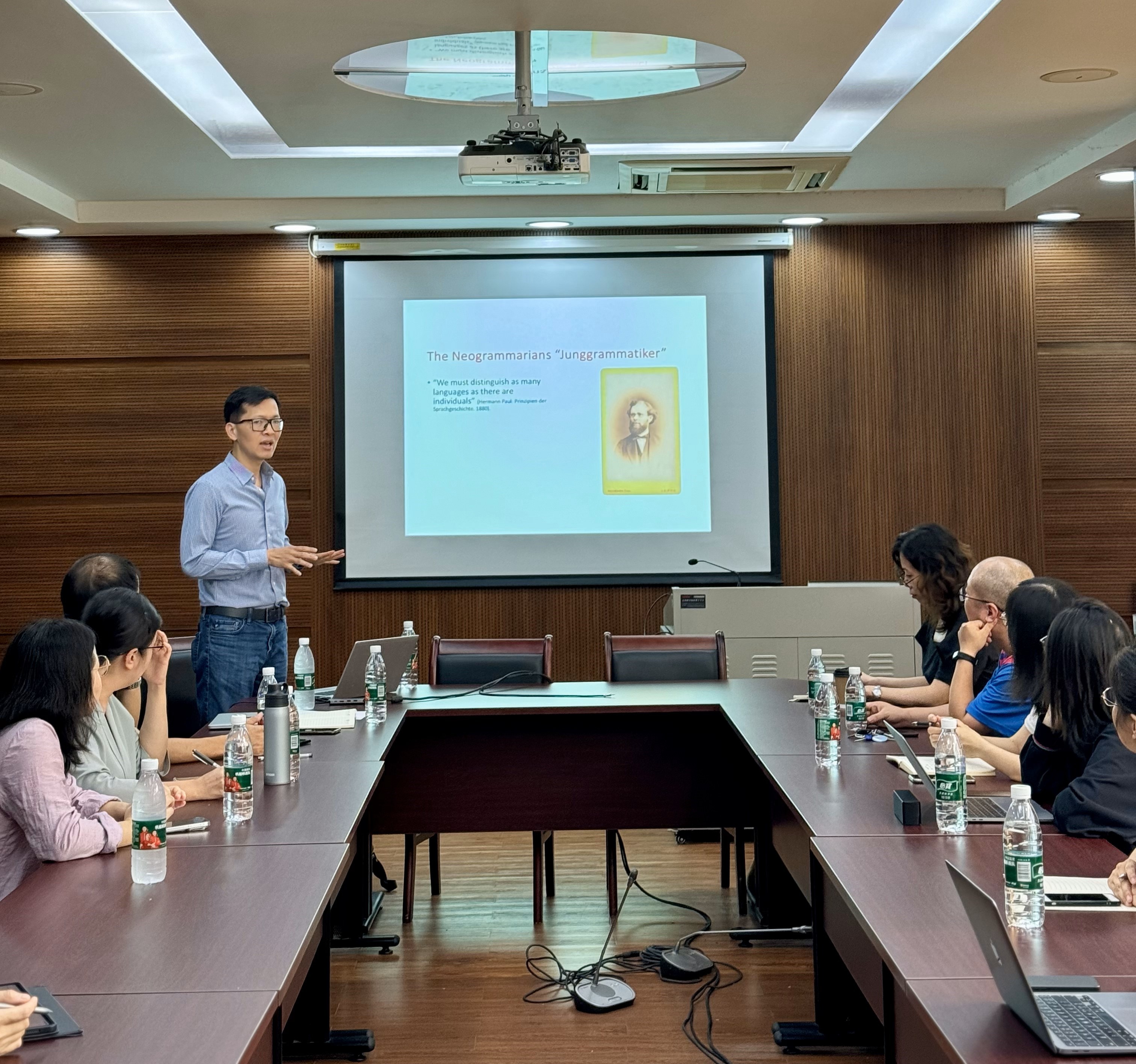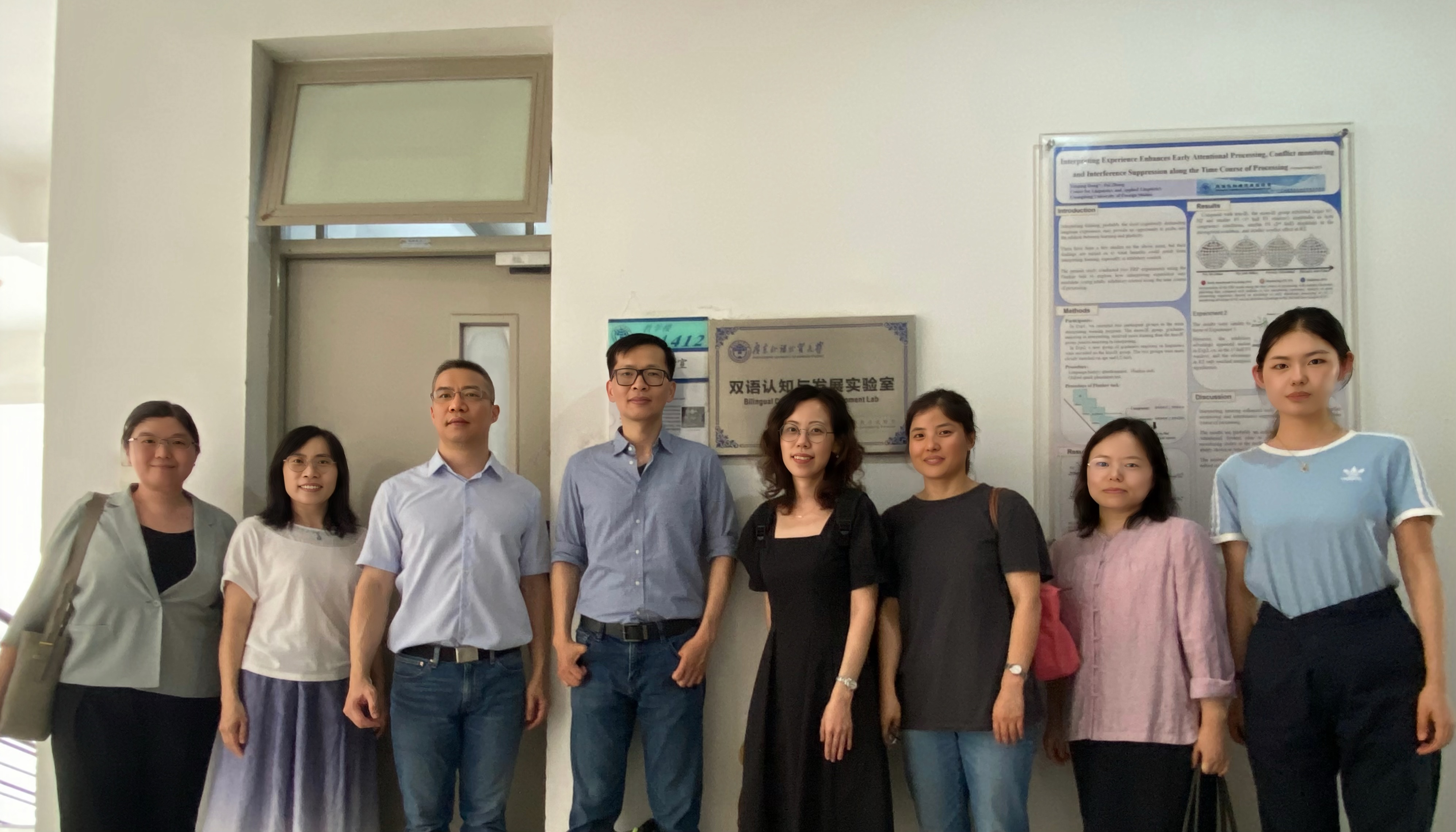2024年7月15日下午,芝加哥大学语言学系主任Alan C. L. Yu教授(the William Colvin Professor)应双语认知与发展实验室邀请做主题报告,题为《语音(不)确定性对词汇激活的影响》(Effects of phonological (un)certainty on lexical activation)。此次讲座在文科基地307会议室举行,由实验室兼职研究员蔡任栋博士主持。参加讲座的听众包括实验室副主任梁利娟教授、中文学院贝先明教授、实验室兼职研究员林洁绚博士、文科基地彭红英博士、英文学院王晓培博士和陈李军博士、英语教育学院陈艾舒博士、暨南大学刘敏博士及校内外研究生和本科生等。

Alan Yu 首先介绍了研究背景——个体会利用语音相关的声学信息与词汇信息进行语音识别,但不同个体对这两类线索的依赖程度有明显差异,这种个体差异的底层机制亟待深入探究。据此,他提出了两个研究问题:(1)语音识别过程中,个体对声学和词汇线索的利用模式是相对稳定的特质(trait)还是因任务而异(task-specific)?(2)如果这种权重关系是个人特质,它的来源是什么? 他设计了两个实验来探究这些问题。实验一考察个体在言语感知中对词汇和声学两类线索的利用,结果表明,两类线索的使用权重存在此消彼长的关系——对声学线索的利用越少,对词汇线索的依赖越强;这种权重关系在对不同语音刺激的感知中存在相关性,说明这种关系不是任务特异的,而是个人特质。具体来说,与词汇线索的依赖程度相关的是使用声学线索识别语音范畴的一致性或确定性(phonological certainty),而词汇线索依赖与范畴识别的渐进程度(gradience)关系较弱。实验二考察个体在噪音遮蔽下词汇识别表现,直接探究词汇效应与声学线索使用的关系。结果发现,个体利用声学线索识别范畴的确定性越低,词汇识别受语音临近词密度(phonological neighborhood density)的影响越大;但范畴识别的渐进程度与词汇效应没有关系。以上结果共同说明,个体对词汇线索的依赖程度与利用声学线索识别语音范畴的确定性相关,这是一种特质,可能源于语音信号在皮层下神经编码的个体差异。

Alan Yu的研究使大家深受启发。听众反响热烈,与他探讨了言语感知中新的个体差异指标及其意义、声学与词汇信息的权重对语音感知、产出以及语音演变的启示等问题。最后在众人的意犹未尽中,蔡任栋做总结并与听众一起对Alan Yu致以真诚的感谢。
讲座结束后,Alan Yu等人参观了实验室,大家就推动合作研究等问题展开充分交流。

Lecture by Dr Alan Yu on “Effects of phonological (un)certainty on lexical activation”
On July 15, 2024, Dr Alan C. L. Yu, the William Colvin Professor, Chair of the Department of Linguistics at the University of Chicago, gave a lecture titled “Effects of phonological (un)certainty on lexical activation” at the invitation of the Bilingual Cognition and Development Lab. This lecture, held in Room 307 of the Center for Linguistics and Applied Linguistics, was hosted by Dr Rendong Cai and attracted faculty and students both from within and outside the university.
Alan Yu first introduced the research background: Individuals rely on both acoustic-phonetic and lexical information to identify speech sounds, but the degree of reliance on these two types of cues varies significantly across individuals. However, explanations and sources of these individual differences remain under-explored. He therefore proposed two research questions: 1) What is the nature of the relationship between acoustic-phonetic cue reliance and lexical reliance? 2) If the relationship is a trait, what is the source of this trait? He designed two experiments to address these questions. Experiment 1 investigated individuals’ reliance on lexical and acoustic-phonetic cues during speech perception. The results showed a trading relationship between the use of lexical and acoustic-phonetic cues; the weaker the reliance on acoustic-phonetic cues, the stronger the lexical reliance. This pattern was not task-specific, but reflected a trait in individuals. Specifically, lexical reliance was related to the consistency or certainty of using acoustic-phonetic cues in identifying speech categories (i.e., phonological certainty), but was less related to the gradience of speech category identification. Experiment 2 examined individuals’ word identification in noise, directly exploring the relationship between lexical effects and acoustic-phonetic cue use. The results indicated that individuals with lower phonological uncertainty tended to be less affected by phonological neighborhood density. However, the gradience of speech category identification was not related to lexical effects. These findings revealed that stronger lexical reliance is related to greater phonological uncertainty. This is a trait that possibly stems from individual differences in subcortical neural encoding of phonetic signals.
The talk provided a novel perspective on understanding individual differences in speech perception. It inspired a heated discussion on the related issues and future directions regarding the use of new individual difference measures in speech perception, and the implications of the fine-grained cue-trading interpretation for speech processing and sound change.
After the talk, Alan Yu and colleagues visited the lab, and discussed how to facilitate collaborative research.
